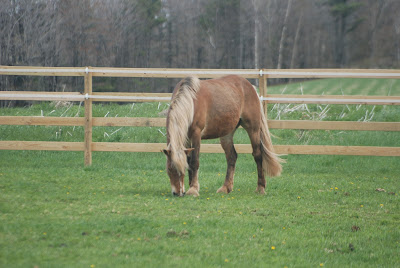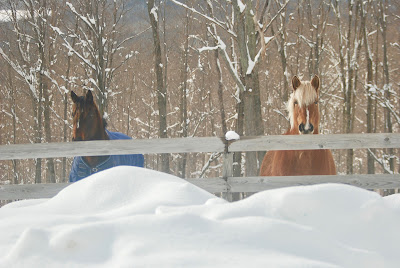Reality check for horse owners in Upstate New York hit fast this year of 2022 with equine vets in short supply in many areas.
The region of the Catskill Mountains seems particularly bereft of equine veterinary care options and represents a 'dead' spot for many horse owners in need of ambulatory vet services for their charges.
Changes in the operations of a vet practice closer to Albany than the counties of Schoharie and Delaware, the reluctance of practices north of the region to send vets more than 50 miles from home base and the lack of specialist equine vets to help horse owners navigate their horse health issues have escalated significantly.
While horse owners in the Hudson Valley have more vets than you can shake a stick at, the Catskill region that is a fast growing equestrian and equine population in New York State, suffers from little to no choice of horse care options.
Rushing a colicky horse or EPM equine to a clinic via horse trailer is not a positive option for the horse or their owner. A laminitic horse will not do well bouncing up and down on a trailer for an hour, and a mare with foal by her side will not enjoy the ride either.
What are horse owners to do? Many vet services are not offering any emergency services at all. Their message machine simply advises horse owners to take their ill horse to the closest hospital such as Cornell, a 2 hour ride away.
Gone are the days of James Herriot's ethic,"You must attend." The note that Siegfried Farnon was often quoted as saying to his hardworking, patient care driven vets.
Some vets in the region are approaching retirement, while others have moved location to warmer climates. Changes notwithstanding, horse owners in the region are asking themselves and each other what can be done.
Overheard at a recent horse event, a lady talking about a large rescue operation in Delaware County with over 100 horses.
" The sanctuary sucks up any vet that shows up. So many horses that are all in need of care. But then every vet seems to burn out and leave, and they are too busy to come to us."
While no-one wants to see any horse go in need of care, especially one at a rescue that has likely already endured major hardship, the need for a vet to attend their own farms has many regional horse folks upset.
Utilizing a specialist equine vet is hardly an option at this point for many. A qualified large animal vet will have to suffice although not surprisingly their experience and forte may not be everything that is needed for horse care however well-intentioned their efforts and hardworking they may be.
Comments that have come in to our online post on the topic include:
" We have been waiting over a month for an appointment. When it finally came, almost all my horses were suffering from some form of tick borne disease. I knew something was wrong, but what could I do. No-one would come and I don't have a trailer."
" I waited 2 weeks for a simple blood test. Meantime my horse was fighting an infection that went untreated, as the vet wouldn't dispense any broad spectrum antibiotics before the results came in."
" None of us wants to self-treat our horses. We need professional help. But what are we to do?"
" I contacted a large equine practice in Rhinebeck to come out, but we are just too far. I do wish someone would open a satellite office. I'm sure it would make good money."
" The large animal vet and her tech that came out were lovely people. But they are rushed off their feet. They can't possibly answer all the needs of the community on their own."
" I would expand my horse business but I can't because I can't get the vet care we need for our lesson horses and breeding program. It is so frustrating. We have these colleges in the region like SUNY Cobleskill that do Equine Studies, but no outreach vet programs or adjunct vet studies there."
" The only vets that will come out want us to guarantee it is worth their while financially and will attend for pre-purchase exams or expensive diagnostics. But good luck with anything else. They take the money quite happily and do the work, but they aren't interested in stuff like vaccines, regular lameness work ups or diagnosis, long term care for tick diseases or emergency suturing and the like."
" There is no billing anymore. The vet just ran my credit card before they'd even sent me a bill to review. That wouldn't be so bad if I didn't then have to wait more than 2 weeks for the reports on X-rays and ultrasounds. But if I complain, they won't come out again."
" There's no question horses are dying and suffering needlessly because we can't get proper vet equine vet care. I just had to euthanize two horses because of missed diagnosis of EPM and Lyme as laminitis. I'm heartbroken."
" We stopped horse breeding and an FEI program here because the vet needs of our horses could not be met. Even as professionals interested in encouraging more education and equestrian opportunities in the region, it simply isn't possible to get vets to come out when we need them."
And the list of comments goes on. Extensively.
What is the solution? The vet shortage issue is nationwide and not just relative to the Catskill region. While horse owners will pay the $1000+ for a simple call out with some bloodwork, a quick exam and a few X-rays, the region simply doesn't have the huge performance horse barns that will encourage a vet to move in to the usually cold wintry region with the lure of big bucks and an endless stream of moneyed horse mavens.
The Catskill region does however offer a beautiful environment in which to work. Clean air, clean water, and a relatively low tax cost/property cost compared to neighboring areas as the taxes are subsidized by the New York Watershed and conservation grants for NYC water needs.
There is a resurgence of art and cultural events and activities in the Catskills and beyond due to investment from New York State in establishing healthy outdoor activities with trails for hiking and riding, and a myriad of other pursuits.
The people of the mountains are generally hardworking, down to earth types that are friendly and quick to lend a hand to others.
Sure, there are many transplants too. This is partly due to Covid migration plus the area is burgeoning into an attractive region for migration for West Coast businesses. The Albany area just an hour to the north has attracted much Silicon Valley investment in recent years, and the Catskills is set to be elevated to new heights of appreciation for its blissful lifestyle as a result.
The area is 'ripe' for an established vet practice or two, to develop a solid business model to serve the horse community, or for a new practice to take the reins and get started and build a sincerely profitable business.
Time will tell. Meantime, sourcing ambulatory horse health care will continue to challenge the horse owners and let us hope that something changes soon.


























